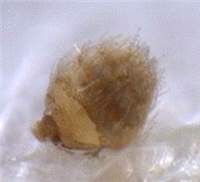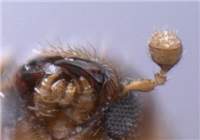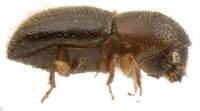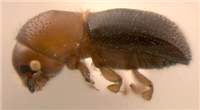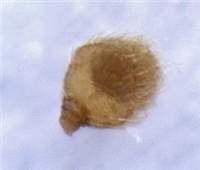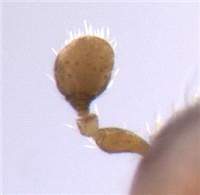Diagnosis
Mostly minute species, size beyond 2 mm rare. Elongated, hairy. Scutellum missing, elytral bases with dense setae associated with mycangium. Elytral disc often convex, with a "hump".
Similar to smaller Coptodryas, but elongated, antennal club mostly type 2 or 3, pronotum never very tall or robust, punctlures on elytral declivity in rows.
Distribution
South Asia, Australia and Oceania. Some species very common.
Biology
Many species create complex tunnel systems with multiple brood chambers and several entrances. This suggests the existence of communal and cooperative breeding, such as that shown for the related Xyleborinus (P. Biedermann, pers. coll.). Despite of minute size, Microperus prefer large logs.Taxonomy
Many Microperus were included in Coptodryas in Wood & Bright (1992). Resurrected as Microperus Wood ( Hulcr et al. 2007) for a monophyletic clade of small, elongated, and relatively uniform species. Cognato et al. (2010) confirmed the monophyly by a molecular analysis.
Detailed description
Eyes shallowly emarginate, upper part smaller than lower part. Structure of antennal club varies greatly, possibly even within single lineage from different locations. Antennal club approximately circular, or appears broader than tall, club type two (obliquely truncated, segment 2 partly visible on posterior side), or three (segment 1 straight or convex). Segment 1 of club covering most of posterior face, its margin fully costate or may appear softer on posterior side, concave, circular around club, or straight on anterior face. Segment 2 narrow, visible on anterior side only, or visible on both sides of club, pubescent or partly corneous on anterior part. Segment 3 absent from or partly visible on posterior side of club. Segment 1 of antennal funicle shorter than pedicel, funicle 4-segmented, scapus regularly thick. Frons above epistoma mostly smooth, alutaceous, with minor punctures, or rugged, coarsely punctate. Submentum shallowly to deeply impressed, shaped as very narrow triangle. Anterior edge of pronotum with no conspicuous row of serrations (serrations no different than on pronotal slope). Pronotum from lateral view elongated, with low summit (type 7), from dorsal view short, parallel-sided, rounded frontally (type 2). Pronotal disc shining or smoothly alutaceous, with small punctures, lateral edge of pronotum obliquely costate. Procoxae contiguous, prosternal posterocoxal process short and conical, or flat and inconspicuous. No tuft on pronotal basis associated with mesonotal mycangium, but elytral bases covered with dense setae associated with elytral mycangium. Scutellum not visible. Elytral bases slightly curved, costate. Elytral disc longer than declivity, flat to convex, punctures in strial lines. Boundary between elytral disc and declivity may be indistinct when disc smoothly transitioned into declivity. Lateral profile of elytral declivity slightly convex, dorsal profile of elytral apex rounded. Elytral declivity sometimes with few setae or scales, not conspicuously pubescent, but more often covered with dense setae. Posterolateral declivital costa ending in 7th interstriae. Inner part of declivity with abundant uniform granules or miniature recurved spines, rarely with large tubercles. First interstriae parallel. Protibiae distinctly triangular, slender on upper part, broad and denticulate on lower part. Posterior side of protibia flat, no granules, only setae. Protibial denticles small, bases of denticles not enlarged, protibial margin rounded, usually between 6 and 8 protibial denticles present. Light brown or reddish, rarely dark brown, pronotum often much lighter (yellow or orange) than elytra. Minute species, 1.1-2 mm, size beyond 2 mm very rare.


